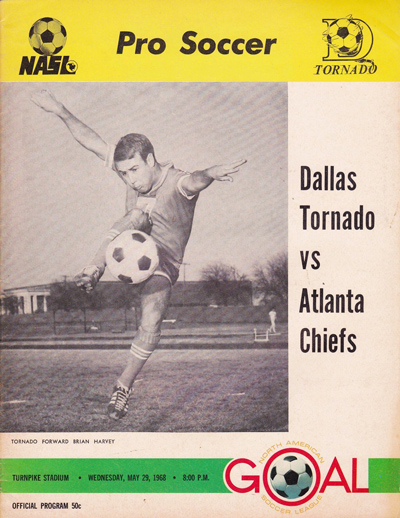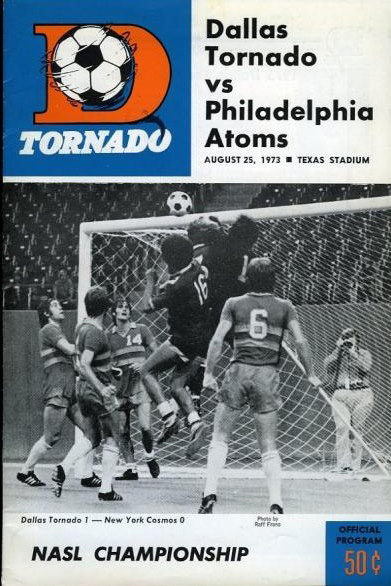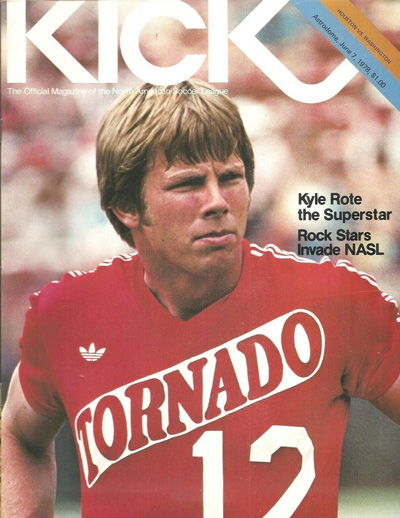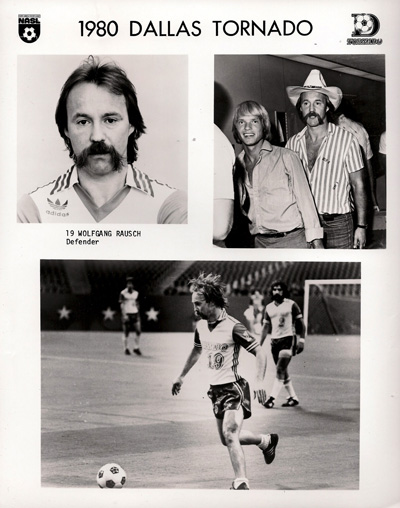United Soccer Association (1967)
North American Soccer League (1968-1981)
Tombstone
Born: 1967 – USA founding franchise
Folded: September 16, 19811ASSOCIATED PRESS. “Hunts folds Dallas Tornado”. The Standard-Times (San Angelo, TX). September 17, 1981
First Game: May 28, 1967 (W 1-0 @ Chicago Mustangs)
Last Game: August 19, 1981 (L 2-1 @ Minnesota Kicks)
USA Championships: None
NASL Champions: 1971
Stadia
Outdoor Soccer:
1967-1968: The Cotton Bowl (75,504)
Opened: 1930
1968: Turnpike Stadium (19,068)
Opened: 1965
Demolished: 1994
1969: P.C. Cobb Stadium
1970-1971: Franklin Field
1972-1975: Texas Stadium (65,000)21975 North American Soccer League Media Guide
Opened: 1971
Demolished: 2010
1976-1979: Ownby Stadium (21,000)31977 North American Soccer League Guide
Opened: 1926
Demolished: 1998
1980-1981: Texas Stadium
Indoor Soccer:
1980-81: Reunion Arena (17,500)
Opened: 1980
Demolished: 2009
Marketing
Team Colors:
Ownership
Owners: Lamar Hunt & Bill McNutt
Background
That the Dallas Tornado existed as long as they did – 15 seasons from 1967 to 1981 – is a testament to the endurance of American Football League founder Lamar Hunt and fruitcake baron Bill McNutt. The Tornado existed longer than the famed New York Cosmos. They developed the first American-born “Superstar” of the soccer (at least by ABC’s definition) in Kyle Rote Jr. But the team was never wildly popular in Dallas. The club wandered around the metroplex in nomadic fashion, shifting among five different stadiums in little more than a decade of play.
The Tornado Shall Be Portrayed This Evening By Dundee United
The Tornado began play in 1967 as charter members of the United Soccer Association (USA). The USA was one faction in a so-called “soccer war” between two upstart leagues in the United States that summer. The USA had formal sanctioning from FIFA and the United States Soccer Football Association, while its rival, the National Professional Soccer League (NPSL) was considered an “outlaw” league. However, the outlaw league was the one that landed the network television contract with CBS, and both leagues boasted deep-pocketed owners from professional football and Major League Baseball. Inspired by the 1966 World Cup, the men behind the USA and the NPSL in 1967 were the first to attempt the mass-marketing of professional soccer in major American cities coast-to-coast.
In the rush to get ready for the 1967 season, the twelve franchises of the USA decided to import entire clubs wholesale from Europe and South American to play under American aliases. The 1967 Dallas Tornado were actually Dundee United of Scotland.
Into The NASL
After one season of competition, the USA and the NPSL merged to form the North American Soccer League (NASL) in December 1967. Meanwhile, the new Tornado – now an assemblage of new European players, rather than Dundee United – embarked on an epic 48-game World tour between August 1968 and March 1969 under Head Coach Bob Kap. The tour took the Tornado around the globe from Spain to the Far East and back to Central America. Along the way, the Tornado stopped in South Vietnam to play two games in Saigon in mid-December 1968, just over a month before the Tet Offensive. The brutal tour schedule did little to prepare the Tornado for the 1968 season though – Kap’s club finished with a league-worst 2-26-4 record in the first season of the NASL and were outscored 109-28.
Twelve of the seventeen NASL clubs folded after the 1968 season. Tornado owners Lamar Hunt and Bill McNutt were among the few investors that decided the forge ahead with a strange 1969 season. In the spring and early summer of 1969, the five remaining NASL teams once again imported foreign clubs as stand-ins for an eight-game round robin “International Cup”. Dundee United returned to masquerade as the Tornado for the International Cup schedule. Then in late summer, the five franchises assembled proper clubs and played a 16-game season. This time the Tornado were competitive under new player/Head Coach Ron Newman, finishing 3rd place at 8-6-2.
Ron Newman Era 1969-1975
The Tornado’s glory years came under Ron Newman’s direction from 1969 to 1975. The Tornado defeated the Atlanta Chiefs to win the NASL title in 1971.
Dallas returned to the 1973 NASL championship game against the Philadelphia Atoms. The club had an exciting young American star in Kyle Rote Jr., who led the league in scoring in 1973 and earned Rookie of the Year honors. Rote was ideally cast for poster boy status for the young league. He was wholesome, good-looking, Christian and the son of former NFL star and TV broadcaster Kyle Rote Sr. His presence in the 1973 title game – along with that of the Atoms’ American goalie Bob Rigby – helped the NASL gain its first Sports Illustrated cover shoot. The match drew 18,824 to Texas Stadium but the locals went home disappointed after a 2-0 Atoms victory.
Lamar Hunt vs. Time Warner
The complexion of the NASL truly changed in 1975 when the Time-Warner owned New York Cosmos signed Brazilian superstar Pele to an unprecedented multi-million dollar three-year contract. The Tornado travelled to crumbling Downing Stadium in New York City to play the foils to Pele’s American debut on June 15th, 1975. CBS televised the match nationwide and it was simulcast in countries all around the globe. When Pele made his first visit to Dallas one month alter, a Tornado record crowd of 26,127 turned out at Texas Stadium to see The King of Football.
The Cosmos didn’t stop there. For the rest of the 1970’s, Time-Warner imported a stream of expensive European and South American stars including Franz Beckenbauer, Carlos Alberto, Johan Neeskens and Giorgio Chinaglia. Nearly alone among NASL team owners, Lamar Hunt possessed the wealth to go toe-to-toe with the Cosmos on player signings. In a 1972 profile, Sports Illustrated related an oft-told apocryphal story from the American Football League’s formation in 1959. A member of the media says to Hunt’s father, H.L. Hunt:
“Mr. Hunt, your son is going to lose one million dollars a year on that new league.”
“Well.” the elder Hunt supposedly replied, “At that rate he’ll be finished in 150 years.”
Rote Departs
Hunt could have taken on the Cosmos, but he chose not to. During the 1976 season, the same year that Pele earned between $900,000 and $1.5 million with the Cosmos (depending on whom you ask), Hunt’s biggest star, Kyle Rote, Jr., earned a $7,000 base salary with the Tornado.
The bulk of Rote’s income apparently came from ABC Sports’ Superstars competition, where he was something of a one-man dynasty. Rote won Superstars in 1974, 1976 and 1977, earning over $150,000 in prize money along the way. In fact, by 1976 Rote’s celebrity profile considerably usurped his on-field role. He was only a part-time starter on his own team. The late 1970’s was the period of the NASL’s irrational exuberance. But Hunt – arguably the league’s richest owner – made only one player move that attracted significant press attention. In October 1978, the Tornado sold Kyle Rote Jr.’s contract to the Houston Hurricane for $250,000.
Stadium Shuffle
Throughout their existence, the Tornado shuffled among a half dozen venues in the Dallas area, beginning in the Cotton Bowl (1967-1968), before moving on to P.C. Cobb Stadium (1969) and Franklin Field (1970-71). In 1972, the Tornado moved into Texas Stadium, home of the Cowboys, for a four year run, then spent another four seasons at Southern Methodist University’s Ownby Stadium, before returning to Texas Stadium for the final two seasons of the franchise in 1980 and 1981. From an attendance standpoint, the club’s high water mark was 1977, when the club average 16,511 at SMU, up from just 4,630 per game two years earlier in 1975. But in 1978, Tornado attendance crashed by nearly 50% to just over 8,900 per game. The team’s popularity continued to decline in the following years.
The 1981 season was especially demoralizing for the loyal core of Tornado fans and for owners Hunt and McNutt. One year after winning the NASL Central Division with an 18-14 record in 1980, the 1981 Tornado dropped to a league worst 5-27 mark. Only 4,670 fans showed up on average in cavernous Texas Stadium, also the worst figure in the 21-team league. At NASL league meetings in August 1981, Hunt and McNutt proposed several kooky rules changes. The owner pitched enlarged goals, replacing throw-ins with kick-ins … something…anything…that might reinvigorate the American soccer audience.
Demise & Aftermath
By September 1981, Hunt and McNutt were finally ready to throw in the towel on the Tornado after fifteen years, part of a seven-team exodus that saw the NASL contract by one-third in the autumn of 1981. The Dallas Morning News estimated Hunt and McNutt’s cumulative financial loss over 15 years at a minimum of $20 million.
The bloom was officially off the rose for the NASL and the euphoria of the Pele/Beckenbauer years seemed far away. Unlike the other departing owners, however, Hunt and McNutt didn’t get out of the league entirely. The pair immediately took a minority stake in the NASL’s popular Tampa Bay Rowdies franchise.
The North American Soccer League folded after the 1984 season.
Lamar Hunt remained a loyal benefactor of top-flight soccer in the United States after folding the Tornado in 1981. Hunt was an original investor-operator in Major League Soccer in 1996. He operated the Columbus Crew and Kansas City Wiz/Wizards franchises through his Hunt Sports Group. In 1999, Hunt Sports Group built $29 million Columbus Crew Stadium in Ohio, sparking a wave of soccer specific stadium construction that stabilized MLS and led to a boom in franchise values during the early 21st century. In 2003, Hunt Sports Group purchased MLS’ Dallas Burn franchise, bringing soccer and the Hunt family full circle in Dallas.
Trivia
The Tornado’s late 1970’s cheerleading squad was known as the ‘Whirlwinds’.
In Memoriam
Brazilian defender Oreco played for the Tornado from 1970 to 1972. He died on April 3, 1985 at age 52.
Tornado owner Bill McNutt died after battling non-Hodgkin’s lymphoma on September 1, 2006 at age 81. Los Angeles Times obituary.
Midfielder Glenn “Mooch” Myernick died on October 9, 2006 after suffering a heart while jogging. He was 51. New York Times obituary.
Tornado owner Lamar Hunt passed away on December 13, 2006. Hunt was 74 years old. New York Times obituary.
Jim Benedek, who played for the Tornado from 1970 to 1973, died of prostate cancer of March 30, 2009 at age 67.
Yugoslav defender Gabbo Gavric (Tornado 1971) died of complications from Parkinson’s disease at age 71 on March 13, 2010.
Argentine forward Omar Gomez (Tornado ’80-’81) passed away at age 66 on May 4th, 2021 from the effects of COVID-19.
Dallas Tornado Video
The Tornado host the Philadelphia Atoms in the 1973 NASL Championship Game at Texas Stadium.
1976 Dallas Tornado promotional film
Downloads
3-5-1978 Tornado vs. Universidad Autonoma de Guadalajara Exhibition Program
3-5-1978 Dallas Tornado vs Universidad Autonoma de Guadalajara Program
5-4-1980 – Tornado @ New York Cosmos Game Notes
11-6-1980 – Mike Renshaw Named Head Coach of Dallas Tornado Press Release
11-24-1980 – Renshaw Please With Effort Despite Loss in Indoor Opener Press Release
4-18-1981 – Tornado vs. New York Cosmos Game Notes
5-25-1981 – Tornado@ New York Cosmos Game Notes
Links
United Soccer Association Programs






2 Responses
I have the complete set of the Young Tornado collector coins – it’s referred to in an ad in the “3-5-1978 Tornado vs. Universidad Autonoma de Guadalajara Exhibition Program” on your site. All 11 players’ coins are in the original display case and I also have an autographed picture of Kenny Cooper, the starting goalie in 1978. I’d be happy to share pics if you’d like them.